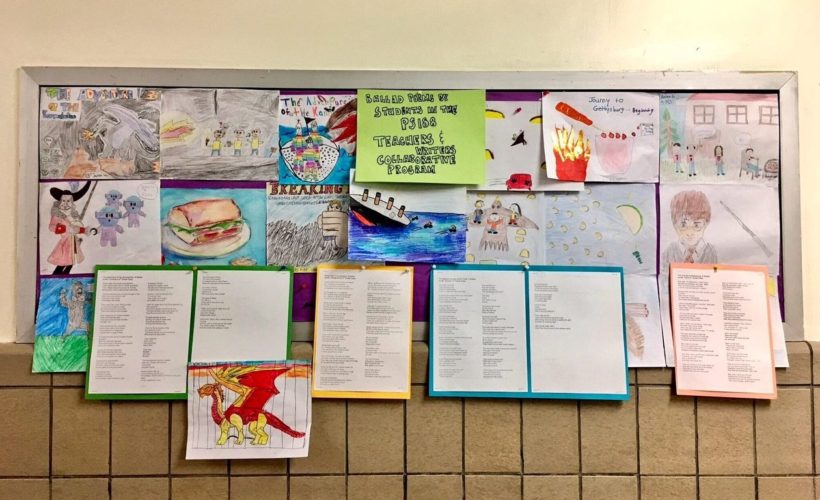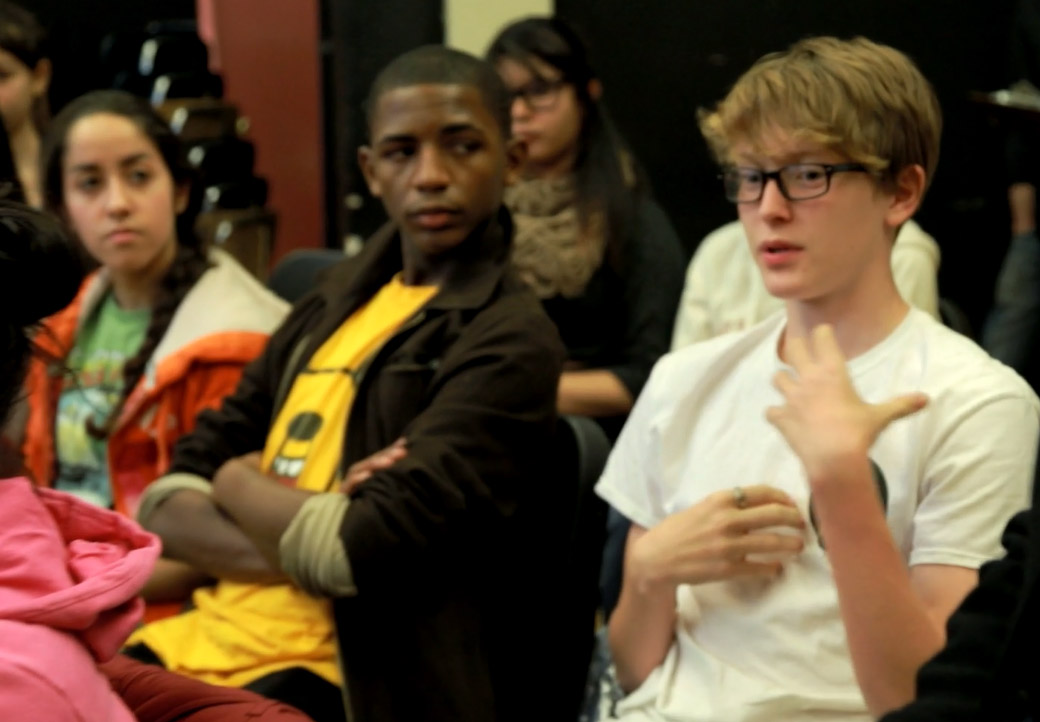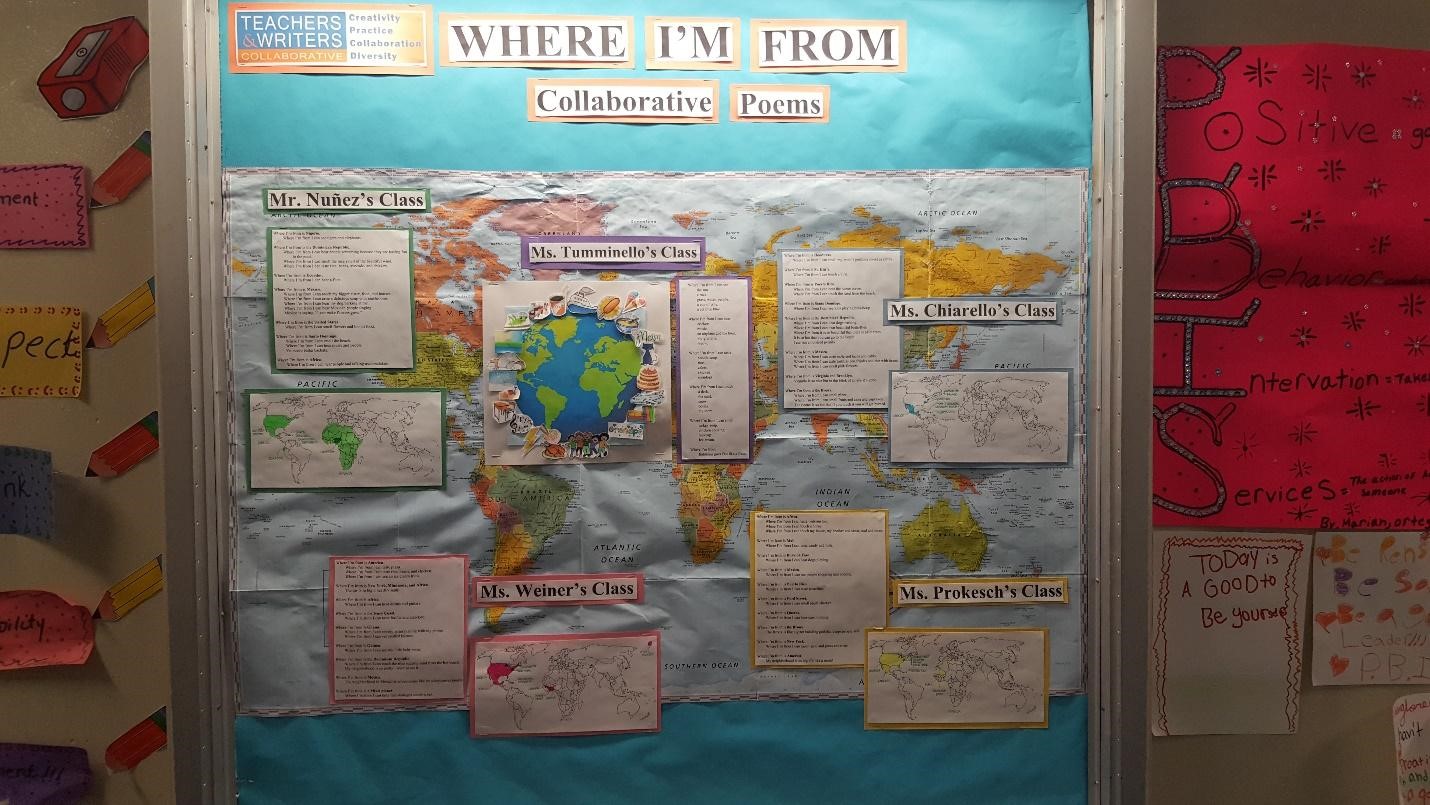T&W teaching artist Amina Henry conducted a 20-session poetry residency at PS 188, the Kingsbury School, in Bayside, Queens with third- and fourth-grade gifted and talented classes. Kirsten Chen, who was a T&W editorial associate in 2016–2017, had an email conversation with one of Henry’s classroom teacher partners, Jessica Wingfield, about the program’s impact.
Teachers & Writers: Has your students’ relationship to writing changed because of this program?
Jessica Wingfield: The students have enjoyed writing even more this year because they were able to express themselves creatively through poetry.
T&W: What is the benefit of having a teaching artist in the classroom?
JW: The benefit of having a teaching artist in the classroom was the ability for students to be able to have a new perspective on how to generate ideas for writing. Amina used writing strategies that were different from mine to help students with the writing process.
T&W: What strategies or ideas have you learned through Amina’s teaching that you feel you will adopt as part of your classroom practice?
JW: I really enjoyed how Amina used mentor texts each week to introduce her lesson. She also engaged students from the start by having them “turn on their imaginations” by using movement and voice. I feel that this was a great way to get students interested from the start of each lesson and made the instruction more dynamic.
T&W: Have you learned anything about yourself as a writer?
JW: After participating in this program I have come to see I am not nearly as creative as my students. Amina’s lessons encouraged me to try and use more creative methods in my own teaching practices.
Sample Lesson from PS 188
Grade: 3
Genre: Poetry
Download: Sample Lesson Plan from PS 188
Common Core Standards (Refer to ELA Standards > Writing > Grade 3)
ELA-LITERACY.W3.3
Write narratives to develop real or imagined experiences or events using effective technique, descriptive details, and clear event sequences.
ELA-LITERACY.W.3.3.A
Establish a situation and introduce a narrator and/or characters; organize an event sequence that unfolds naturally.
Lesson Objective: Explore the relationship between observation, specific detail, and impactful poetry by writing a Walk Poem.
LESSON PLAN
Warm-Up (5 minutes)
Ask students: What did you see on your way to school this morning? What did you smell? What did you taste? How did you select the item you described? What sense did you use to observe the item? Introduce the fact that they can engage other senses to describe something. What language did you use to describe the item? What other senses could you have used to describe your object?
Introduction (5 minutes)
Today we’re going to make further observations and write a poem about what we observe. The Walk Poem involves taking a walk. Writing poems about a walk has a long history going all the way back to ancient Greek literature. Here are some basic types of walk poems:
- A poem about what the poet sees during a particular walk.
- A poem that reflects the way the mind works during a walk.
- A poem whose length, style, and shape mirror the length, style, and shape of a walk.
Ask students: How long is a walk? What are the different types of walks you have gone on? What does a walk look like? What shape is it?
Mentor Text and Discussion (10 minutes)
Today we are going to read “A Bird Came Down the Walk” by Emily Dickinson, and then we are going to write our own Walk Poems.
After you have read the poem with students, ask: What are words or phrases that strike you immediately? What does Dickinson see on her walk? What is the bird doing? What specific images does the poet give us? What is the general mood or tone of the poem? How does the poem make you feel?
Main Activity (20 minutes)
Tell students: Now we are going to take our own walks. We are going to walk silently so that we can focus on observing what is around us. As you are walking, I want you to think about things like size, shape, color, and texture. How would you describe what you see to someone else? Is there a possible story being told in what you observe? (1 minute)
Students walk silently around the room, making silent observations. (3 minutes)
Students return to their seats quickly make a list of everything they observed during their walk.
Ask students to circle the item/s they want to explore in their writing. (3 minutes)
Say: Now we’re going to write a three-stanza poem. For your poem, you’re going to pick either one thing that you observed and describe it in three stanzas, or three things that you describe in three stanzas. What is the thing you saw on your walk that had the most impact? What did it look like, smell like, feel like? What did it make you think about, or feel? What mood do you want to convey in your poem and how can you create that?
Students write for 10 minutes.
Say: Now I want you to read your poems over silently to yourselves. Pick one or two words or phrases and see if you can make them more specific, or more delicious. For example, what might be another way to describe the color red?
Give students 2-3 minutes to revise.
Sharing and Closing (10 minutes)
Invite a few students to share their poems with the class. Invite the rest of the students to pay close attention to the language being used in their peer poems. They might write down words or phrases that they particularly like.
Walk Poem
By Hailey, third-grader, PS 188People walk on the
Ground beside meImagining summer
Birds behind meBooks and projects
And a poem tooSmartboard on and off
Projects people made about
CultureStuffed animals sit
As still as stone
Windy wind blowing them home
Outside
Now we wait
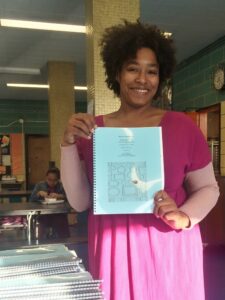
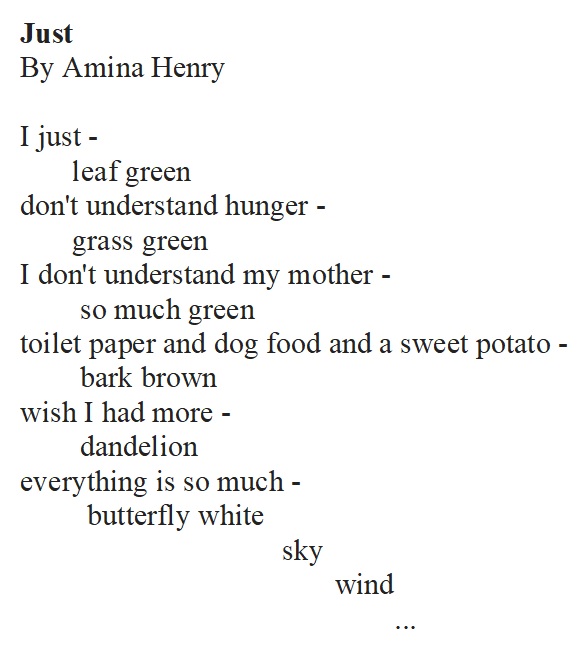
T&W is grateful to E.H.A. Foundation for making this program possible.
Amina Henry is a Brooklyn-based playwright and educator. Recent local productions include PS (Ars Nova), Little Rapes (The New Group/Long Island University), and The Johnsons(JACK). Her work has been produced, developed by, and/or presented by: Atlantic Theatre, The New Group, Clubbed Thumb, New Georges, The Flea, Page 73, Project Y Theatre, National Black Theater, Little Theater at Dixon Place, The Brooklyn Generator, The Brick, HERE Arts Center, The Cell: a 21st Century Salon, the Oregon Shakespeare Festival in the 2013 Black Swan Lab Series (Ashland, OR), Kitchen Dog Theater (Dallas, TX), and HERO Theatre (Los Angeles, CA), among other organizations. She was a 2017-18 recipient of the Lower Manhattan Cultural Council Space Residency and is a 2018 recipient of a space residency at Dixon Place. She is a member of the Women's Project 2022-24 Lab and an affiliate artist at New Georges. She is currently an adjunct lecturer at Brooklyn College and SUNY Albany. She is also a teaching artist for Teachers & Writers Collaborative and the Hunts Point Alliance for Children.

